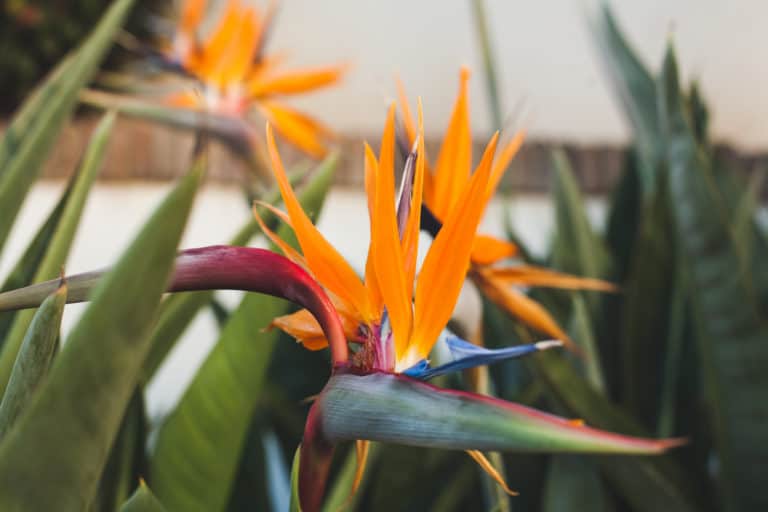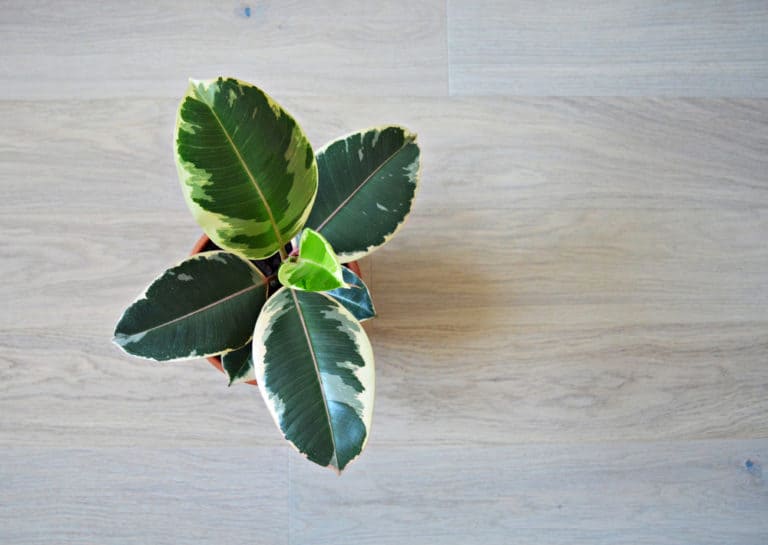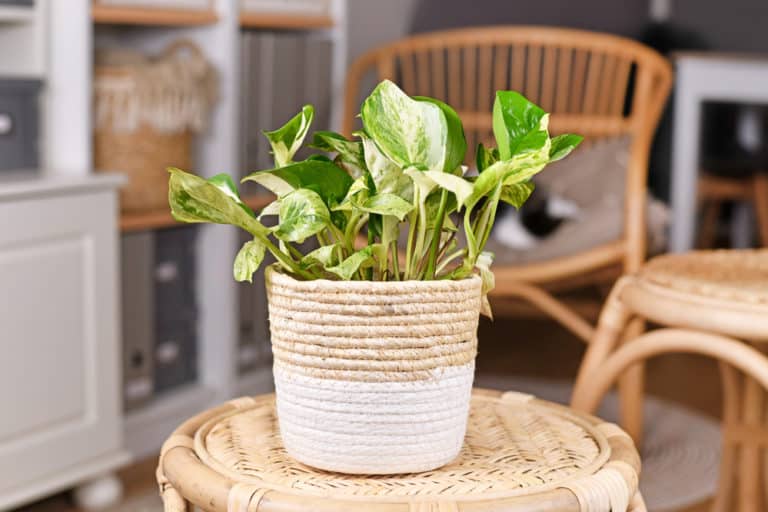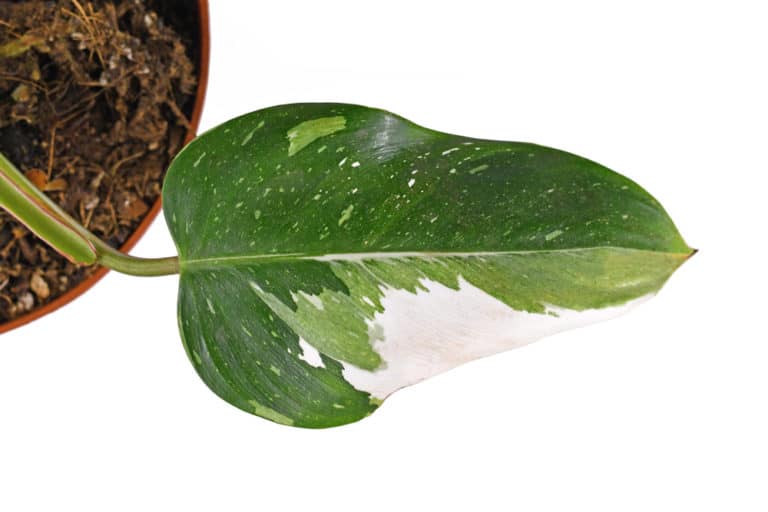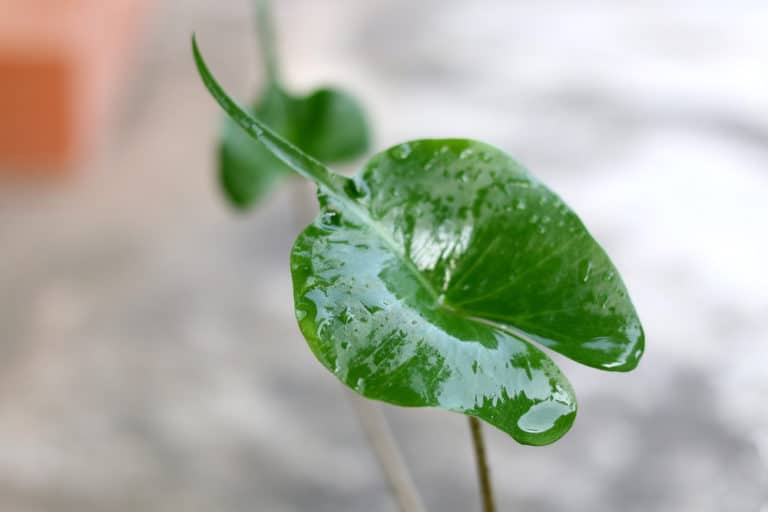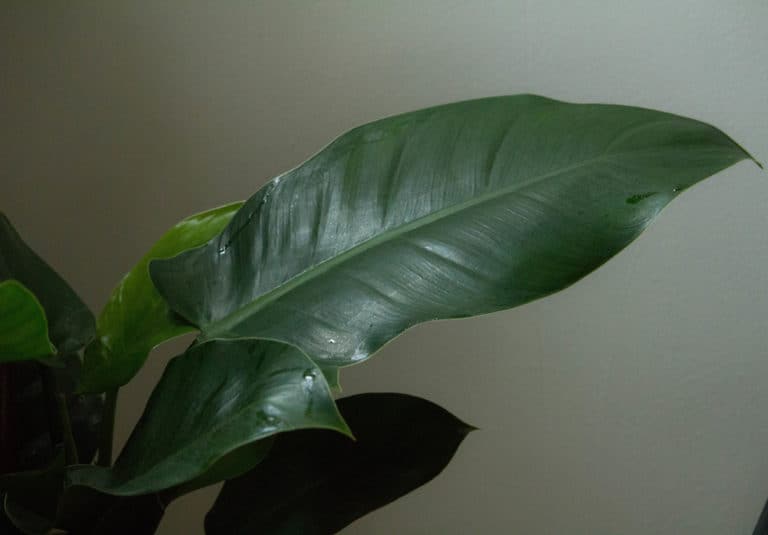Hoya Australis ‘Lisa’ Care Guide (2024)
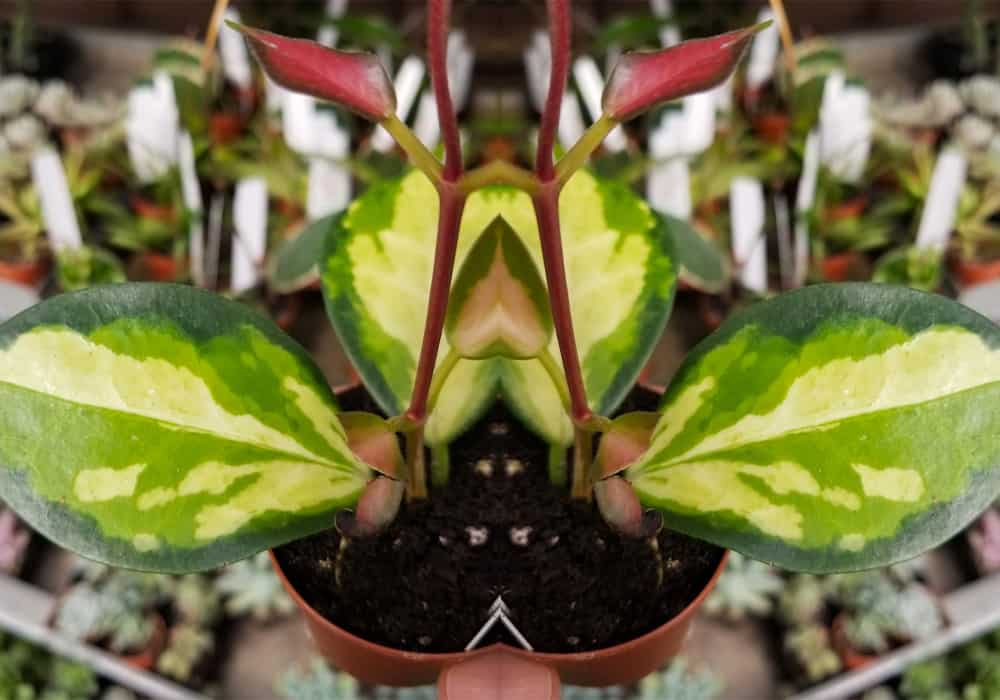
Hoya australis Lisa is a stunning new cultivar of the Hoya plant which has been available since the early 2000s.
Hoya Lisa shares the vining habit of its parent plant but was engineered to have variegated leaves in shades of yellow, chartreuse, and green.
It’s an easy to grow houseplant even for beginners.
| Scientific Name | Hoya australis ssp. tenuipes ‘Lisa’ |
| Common Name | Wax Vine, Common Wax Flower |
| Light | Bright indirect sunlight |
| Watering | Weekly, water if the top half of the soil is dry |
| Temperature | 65-80°F (18-26°C) |
| Hardiness Zone | 10-11 |
| Humidity | 40-60% |
| Soil Type | Loose, well-draining soil |
| Soil pH | 6.1 to 7.5 (mildly acidic to neutral) |
| Fertilizing | A balanced feed every 2-3weeks in spring and summer |
| Repotting | Every 2-3 years |
| Pruning | Beginning of the growing season |
| Propagation | Root in water or soil |
| Toxicity | Mildly toxic to humans and pets |
| Mature Size | 10-foot vine as a houseplant |
| Bloom Time | Summer and autumn |
What’s Unique About Hoya australis Lisa?
The Hoya australis Lisa plant has never grown in the wild. While the Hoya australis is native to northeast Australia, this cultivar was first developed after 2000.
Hoya australis Lisa plants are prized for their stunning leaves, featuring shades of green, chartreuse, and yellow.
In addition, the Hoya Lisa flower is fragrant and beautiful, adding to the overall charm of this tropical vine.
And to top it all off, growing Hoya australis Lisa is easy, even if you’ve never tended an indoor garden before. It’s relatively undemanding in its requirements for healthy growth, and very forgiving if you forget to water it.
Hoya australis Lisa Care
Hoya australis Lisa plant care is pretty easy. Once you’ve potted it up in loose, well-draining soil, and found a spot for it out of the direct sun, all you have to do is water and fertilize it occasionally.
Hoya Lisa care is not difficult to master, and you will be rewarded with a beautiful houseplant.
Light
In the rainforests of northern Australia where Hoya australis originates, these vining plants grow in the shade of the tree canopy.
Thus, Hoya australis Lisa light requirements are for bright but indirect light, or between 10,000-20,000 lux.
You can easily accommodate Hoya Lisa light needs by setting its planter next to a north or east-facing window where the light never becomes too intense.
In a room with a south or west exposure, you will need to find a spot where Hoya australis Lisa will be out of the full sun. The strong afternoon rays can damage the leaves.
Watering
The watering needs for Hoya australis Lisa reflect the conditions in which Hoya australis vines originated.
The soil in the rainforests drains quickly, so they not only tolerate dry soil but need it for healthy growth.
In fact, even if you forget to water Hoya Lisa and the soil dries out entirely, the plant can usually be revived successfully. The leaves retain water for use during dry periods.
In its summer growing season, Hoya australis Lisa watering should be done when the top half of the soil has dried out.
When it goes into its dormant phase in winter, let the soil dry out almost completely, and water sparingly.
Temperature
The ideal Hoya australis Lisa temperature range is 65-80°F (18-26°C). You can usually provide this temperature for Hoya Lisa in a heated home without extra heating.
While it does have some temperature tolerance below that range, sustained periods at temperatures lower than 50°F (10°C) will interfere with its growth.
Even being exposed to direct blasts from air conditioning vents can be damaging to this tender tropical plant.
Finally, Hoya australis Lisa has no frost hardiness at all. While you may certainly move its planter outside in hot summer weather, be sure to bring it back inside well before freezing temperatures arrive.
Humidity
Hoya australis is a rainforest native, so it is acclimated to high humidity.
The ideal humidity for Hoya Lisa is 40-60%. Most homes can meet the lower range of Hoya australis Lisa humidity requirements.
However, if your humidity level is much below 40%, you may want to group all your tropical plants together around a small humidifier.
Another alternative is to place them on a pebble tray filled with water. Just make sure that the pot is above the water level so the soil doesn’t get saturated.
Finally, you can just gently mist the foliage every few days to give them some more moisture.
Soil
Hoya australis Lisa soil has to be porous and well-draining, as the roots will not tolerate being in wet soil. The pH level for Hoya Lisa is 6.1 to 7.5, or mildly acid to neutral.
If you can get a soil mix for cacti, that’s good soil for Hoya Lisa, as the two plant families have very similar needs.
You can’t use straight potting soil for Hoya australis Lisa, as it will not let the roots get enough oxygen.
Instead, mix 1 part potting soil with 2 parts perlite and 1 part peat moss for a good, loose soil mix.
Fertilizer
You will need to use fertilizer for Hoya Lisa. A good fertilizer ratio is a standard 10-10-10, which most indoor houseplant fertilizers have.
The easiest Hoya australis Lisa fertilizer is a liquid fertilizer solution that you can dilute to half strength and use every 2 to 3 weeks in the growing season. Do not use any during its winter dormant period.
If you use well-rotted compost instead of potting soil when potting your Hoya australis Lisa, you will not need to fertilize at all.
You can also add slow-release fertilizer granules to the soil at the start of the growing season in spring.
Potting & Repotting
Hoya australis Lisa repotting only needs to be done every 2 or 3 years. Hoya australis Lisa doesn’t mind being a little root-bound, and in fact, is more likely to flower under those conditions.
However, when you start to see roots growing out of the drainage holes, it’s time for repotting Hoya Lisa.
Your first priority in choosing a new pot is to make sure it’s got good drainage holes. Only go up one pot size, or at most 2 inches in diameter. You do not need to use a very deep pot as it has shallow roots.
When potting Hoya australis Lisa, use a fresh soil mix and settle it in firmly.
Pruning
Hoya australis Lisa pruning should be done in spring at the start of its growing season.
You will of course be able to cut off any dead or damaged leaves whenever you see them throughout the year.
Aside from that, you should cut out stems with smaller leaves, and trim any stems that detract from the overall appearance of the vine. Cut just above a leaf node to encourage bushier growth.
While you can cut off faded flowers, leave the spurs intact as new flowers will form on them in the future.
When cutting Hoya Lisa, use a sharp, sterilized knife or pair of scissors.
Propagation
Hoya australis Lisa propagation is done by layering or rooting stem cuttings in spring or summer.
To propagate Hoya Lisa by layering, simply take a stem and gently tuck it down into a pot right next to your mother plant. Hold it down to the soil surface with a greening pin. When you see roots forming, cut the stem to separate it from the original plant.
For stem cuttings, select young stems with at least 2 leaf nodes. Cut just below a node, and place the cutting into either a jar of water (change the water every few days) or damp soil. Keep the cuttings in a warm, humid spot, and within a month you should have baby plants ready to pot up.
Also, make sure to check out our in-depth Hoya kerrii plant care guide.
Common Problems of Hoya australis Lisa
Keeping an eye on your Hoya australis Lisa leaves is the best way to avoid the development of serious problems with Hoya Lisa.
Hoya australis Lisa problems include common houseplant pests and fungal diseases from too-wet soil.
Luckily, if you catch them early, you will be able to keep your Hoya australis Lisa thriving.
Pests
The most common Hoya australis Lisa pests are mealybugs, aphids, and whiteflies. If you find any of these bugs on your Hoya Lisa, you must take immediate action before the insect population gets out of control.
Mealybugs look like little cotton specks on the underside of the leaves. Remove them by wiping them off with a cotton ball soaked in rubbing alcohol.
Aphids are little green insects that suck sap from juicy stems and leaves. You can rinse them off with a strong stream of water. Use yellow sticky traps to catch any that turn up later.
Whiteflies are usually found on the underside of the leaves. Suck them up with a handheld vacuum.
Use an insecticidal soap or neem oil spray once a month to prevent infestations.
Diseases
Hoya australis Lisa diseases are usually the result of too much water in its soil. These conditions encourage the development of fungal diseases that will kill your Hoya Lisa if not treated.
If leaves are turning yellow and stems are mushy, your Hoya australis Lisa has root rot. You need to remove it from its pot and trim away any blackened roots. Cut off all affected leaves and stems and repot in fresh, loose soil.
Poor air circulation and wet leaves can foster leaf spots or blight, with yellow spots that spread and turn black. Cut off all diseased leaves and use a fan set on low nearby to move the air around.
Growing Problems
Many growing problems are not caused by disease. If you’ve got a sick plant, it may just need a change in its growing conditions.
If the leaves are yellowing, you are probably overwatering. If the soil is really wet, it’s best to give it fresh, loose soil rather than wait for it to dry out.
If your Hoya australis Lisa’s leaves are shriveled and limp, you need to water. Soak the pot in water, and then let all the excess drain out.
If the leaves seem bleached or have brown, crispy edges, you are giving your Hoya australis Lisa too much sun. Screen it with a light curtain or move it to a shadier spot.
Toxicity of Hoya australis Lisa
While Hoya Lisa is often considered non-toxic to humans and pets, it does have some toxicity.
Its sap contains latex, which can irritate a pet’s digestive system or cause a rash. In rare cases, a latex allergy can trigger more serious reactions.
Hoya australis Lisa should be treated with some caution to prevent problems.
For Humans
Hoya australis Lisa is usually just mildly toxic to humans.
If children ingest any of the plant material, they could get an upset stomach from the latex, resulting in vomiting and diarrhea. This can be treated at home.
The sap of Hoya australis Lisa can also cause mild skin irritations, so wear gloves and wash off any that gets on your skin.
However, if someone with a latex allergy is exposed to the sap, they could have an anaphylactic reaction which is potentially life-threatening. If their throat swells up or their skin is rapidly covered with hives, seek medical care immediately.
For Pets
The latex in Hoya australis Lisa sap can have an adverse effect on pets. Eating part of the plant can result in vomiting and diarrhea as the body works to expel the substance.
If those are the only symptoms, just let it run its course. Luckily, Hoya australis Lisa tastes horrible so your cat or dog is unlikely to do more than take a little nibble.
To prevent the small members of your household from getting at your Hoya australis Lisa, find a spot for it out of their reach.
This vining plant is perfectly happy trailing out of a hanging basket or on a high shelf, so you should have no trouble keeping everyone safe.
Hoya australis Lisa Appearance
The Hoya australis Lisa appearance is the result of a hybrid cross and is prized for its variegated foliage and fragrant flowers.
Hoya australis Lisa’s vining habit and rapid rate of growth gives you a lot of options when it comes to using this rainforest beauty in your indoor tropical garden.
Foliage
The waxy foliage of Hoya australis Lisa is splashed with shades ranging from deep green through lime and chartreuse to bright yellow and cream.
When a new leaf emerges, it adds even more to the color palette, as juvenile leaves are pink.
The leaves of this semi-succulent evergreen are thick and leathery and retain moisture to supply to the plant in times of drought. This is why it can be so forgiving of underwatering.
You should wipe down the leaves of your Hoya australis Lisa once a month or so to keep them free of dust or grime. Use a damp cloth with a drop of neem oil.
Flowering
Hoya australis Lisa flowering is likely to occur when it is grown under perfect conditions. The waxy white or pink flowers grow in clusters and have a pleasant scent.
The usual blooming period is late summer and autumn, but if you are lucky, Hoya australis Lisa may bloom more than once a year.
Hoya australis Lisa produces flowering spurs or peduncles which should not be trimmed off after flowering, as new flowers will appear in time.
To encourage flowering, provide your Hoya australis Lisa with 12 hours of light and 12 hours of darkness a day. You may need to use artificial lighting or screen it from light to achieve that balance.
Size and Growth
Hoya australis Lisa has a fast growth rate and may grow several feet in length during one growing season.
The mature size of Hoya australis Lisa can be as long as 10 feet when grown indoors, although some may only reach 3 feet.
When grown outdoors in a tropical region, vines may extend as far as 30 feet.
Hoya australis Lisa grows best when given some support for its vines. Use a bamboo stake or sphagnum moss pole to train the vines up. It also can be grown in a hanging basket so that its stems can spill over and down.
Hoya australis Lisa Fragrance
The Hoya australis Lisa fragrance is yet another reason to grow this showy tropical vine. The lovely flowers have a pleasant scent.
The fragrance is sweet and strong, with hints of vanilla and chocolate. If you move your Hoya australis Lisa outdoors in summer, you can expect to see lots of butterflies and other beneficial insects attracted to it.
The beautiful scent increases in intensity as the evening approaches, so place your Hoya australis Lisa near where you relax as the day draws to a close. A shady spot on a patio would be a perfect location in the summer months.
Suggested Uses for Hoya australis Lisa
With its attractive appearance, there are many spots that can benefit from the addition of a Hoya australis Lisa plant. Its undemanding care requirements make it even more ideal to use indoors.
Since it is a naturally vining plant, you can train it to grow vertically up support to fill in a corner out of the bright sun. Another alternative would be to let it cover a trellis for a living screen in a studio apartment.
Hoya australis Lisa can also be planted in a hanging basket or set on a high shelf where its stems will trail down to soften a space.
FAQ
What is Hoya australis Lisa?
Hoya australis Lisa is a recent hybrid of the Hoya australis vine, native to the tropical rainforests of Australia. It is grown as a houseplant.
How to identify Hoya australis Lisa?
Hoya australis Lisa is a vining plant with semi-succulent leaves splashed with shades of green and yellow, with juvenile leaves in shades of pink and red.
How to care for Hoya australis Lisa?
Hoya australis Lisa plants should be grown in loose, well-draining soil and kept out of the direct sun. Water only when the soil is almost dry.
How to grow Hoya australis Lisa indoors?
Hoya australis Lisa should be planted in a pot with good drainage and kept in bright, indirect light. Water only when the soil is drying out.
How to grow Hoya australis Lisa outdoors?
Hoya australis Lisa can be grown outdoors year-round in zones 10 and above. Plant it in a semi-shade and provide it with support for its vines.
How fast does Hoya australis Lisa grow?
Hoya australis Lisa can grow several feet in one year during its growing season of spring and summer. It will not grow longer during its fall and winter dormancy.
How tall does Hoya australis Lisa grow?
Hoya australis Lisa can grow to a mature size of 10 feet when grown as a potted plant. When planted outdoors in a tropical region, it can reach 30 feet.
How to make Hoya australis Lisa grow faster?
Hoya australis Lisa will grow its fastest when it is given ideal conditions of warm temperatures, indirect light, infrequent watering, moderate humidity, and monthly fertilizing.
How to stake Hoya australis Lisa?
Hoya australis Lisa should be staked with a bamboo stick or a sphagnum moss pole, as it is a climbing plant that requires support for optimum growth.
How to pot Hoya australis Lisa?
Hoya australis Lisa should be potted in a terra cotta pot with good drainage, using loose, well-draining soil with lots of peat moss and perlite to lighten the mix.
How to revive Hoya australis Lisa?
Hoya australis Lisa will exhibit shriveled, drooping leaves when the soil has dried out. Soak the pot thoroughly in water and let the excess water drain out.
Why is my Hoya australis Lisa dying?
Your Hoya australis Lisa may have a fungal disease encouraged by overwatering. Cut out all damaged tissues and repot with fresh well-draining potting mix. Water less often in the future.
Why is my Hoya australis Lisa drooping?
Your Hoya australis Lisa may be too dry or too wet. If the soil is dry, water it slowly so it will absorb properly. If it’s too wet, replace the soil.
How cold can Hoya australis Lisa tolerate?
Hoya australis Lisa will tolerate temperatures below 50°F (10°C) for short periods, but it will cause damage to the plant long-term. Freezing temperatures will kill it.
How to get rid of pests on Hoya australis Lisa?
If you find insects on your Hoya australis Lisa, use insecticidal sprays such as neem oil or insecticidal soap to eliminate the infestation and prevent new ones.
Is Hoya australis Lisa toxic to cats?
Yes, Hoya australis Lisa is mildly toxic to cats because of the latex in the sap. Ingesting the leaves can cause vomiting and diarrhea that can usually be treated at home.
Is Hoya australis Lisa toxic to dogs?
Yes, Hoya australis Lisa is mildly toxic to dogs. Eating any part of the plant can cause a reaction to the latex in the sap.
Is Hoya australis Lisa toxic to children?
Yes, Hoya australis Lisa is mildly toxic to children. They may experience vomiting and diarrhea. If they have a latex allergy, take them to the emergency room.
Is Hoya australis Lisa toxic to humans?
Yes, Hoya australis Lisa is mildly toxic to humans, although people with a latex allergy could have a life-threatening reaction. The sap can also cause skin irritation.
Does Hoya australis Lisa have a scent?
Yes, Hoya australis Lisa’s flowers have a sweet scent with hints of vanilla and chocolate. The waxy white flowers usually bloom in late summer and autumn.

